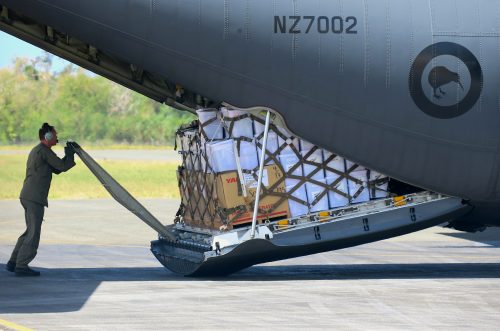Aid, influence and ‘strategic anxiety’ in the Pacific

In February 2018, New Zealand’s Foreign Minister Winston Peters announced his new government’s commitment to revitalising relations with the Pacific.
He argued that a renewed foreign policy focus on the Pacific is necessary because the region has ‘become an increasingly contested strategic space’ and an area of ‘strategic anxiety’ for Australia and New Zealand. This claim echoes recent comments from Australian journalists and think-tank contributors.
The Pacific is certainly attracting the interest of a number of external states. But few of them have strategic reasons for engaging with the Pacific’s island states, and some are more interested in cooperation than in competition with New Zealand and Australia.
The United Arab Emirates (UAE) is the world’s largest donor per capita of official development aid, and its UAE–Pacific Partnership Fund, which aims to promote the use of renewable energy sources in the region, has involved support from and cooperation with New Zealand.
France’s recently increased Pacific presence is a reminder to the world that it remains a global power. Its presence is welcomed for its leadership on EU engagement with the island countries and for its contribution to maritime surveillance and disaster response. France and Australia also have shared concerns about Chinese ambitions in the more strategically significant Indian Ocean.
India seeks the support of the Pacific states for its efforts to gain a permanent seat on the UN Security Council, but it cannot afford to give much aid to the islands. In any case, it is seen as an important partner for Australia and other Asia Pacific powers that are concerned about China’s rise and uncertain about US regional commitment.
Russia’s engagement with the Pacific island states is limited and prompted largely by its search for diplomatic support in its disputes with neighbouring countries such as Georgia.
Both Taiwan and Japan have a longstanding presence in the Pacific due to their interest in the region’s fisheries. Japan shares Australia’s wider strategic concerns and the two countries have an increasingly close security relationship. Taiwan is engaged in competition in the South Pacific but not with the regional powers. Its contest is a diplomatic one with China over global recognition of the ‘one China’ policy.
There is thus little-to-no strategic competition with Australia and New Zealand among most nations involved in the Pacific. What about China?
The provision of Chinese aid to the Pacific was originally motivated by its desire to prevent Taiwan from winning diplomatic supporters — an imperative that has never disappeared. But this competition does not fully explain the increase in Chinese aid and loans to the Pacific island countries, which is best seen as a regional manifestation of China’s wider strategy of engagement with the developing world.
In the mid-1990s China re-evaluated its approach to foreign aid and has since put much energy and funding into strengthening its relations with developing countries. It changed its aid focus and began offering soft loans and encouraging cooperation between local and Chinese companies.
China wants to demonstrate that it is a responsible power whose economic rise will not come at the expense of smaller developing states. It also seeks to garner support for election to UN bodies such as the Human Rights Council and for its positions on Taiwan, Tibet and the South China Sea.
Economic and strategic considerations do factor into China’s external engagement, but not everywhere. Some countries in the developing world, especially in Africa, offer China access to resources and large markets, while some, like Djibouti and Sri Lanka, are situated along China’s important trade routes and offer naval basing opportunities.
By contrast, China’s engagement in the small, comparatively resource-poor and remotely situated islands of the South Pacific has mostly diplomatic motivations (with the possible exception of its engagement in Papua New Guinea) and has been enabled by the actions of the island states’ traditional partners of Australia and New Zealand.
Australia is now concerned about China’s increased engagement with the South Pacific. While Australia does have a long history of fretting about great-power intrusion into the region, its concerns may also be influenced by alliance considerations.
It is vital for Australia to maintain its alliance with the United States and to encourage a continuing US presence in the Asia Pacific. But the interests of allies are not always identical and Australia is also trying to maintain some flexibility in deciding its operational commitments.
The existence of security concerns and Australia’s perceived responsibilities in the South Pacific allows Australia to claim that it is sharing the burden of collective security, and this gives it room to negotiate in the event of US pressure to make a greater commitment to US operations elsewhere.
While the notion of a ‘China threat’ may resonate with the US administration and has preoccupied Australian commentators of late, the Australian and New Zealand governments have reason to fear the regional manoeuvers of another country altogether.
Indonesia has been making a concerted effort to limit the effects of rising pro-West Papuan sentiment in the South Pacific, and its strategy includes offering regional governments funding and training in domestic and transnational policing.
While Indonesia’s initiatives may not be designed to contest antipodean influence, they have the potential to undermine Australia and New Zealand’s regional and global image as the island countries’ principal security partners.
Concern about this eventuality will likely explain Australia’s and New Zealand’s stepped-up engagement with the Pacific Islands as much as any fear of ‘great power ambition’.
This article was published by the East Asia Forum.
Nicola Baker is Senior Lecturer and Director of the Diplomacy and International Affairs Programme at the The University of the South Pacific in Fiji. Her research interests include the geopolitics of the South Pacific, New Zealand’s place in Pacific regionalism and Taukei voting behaviour.













